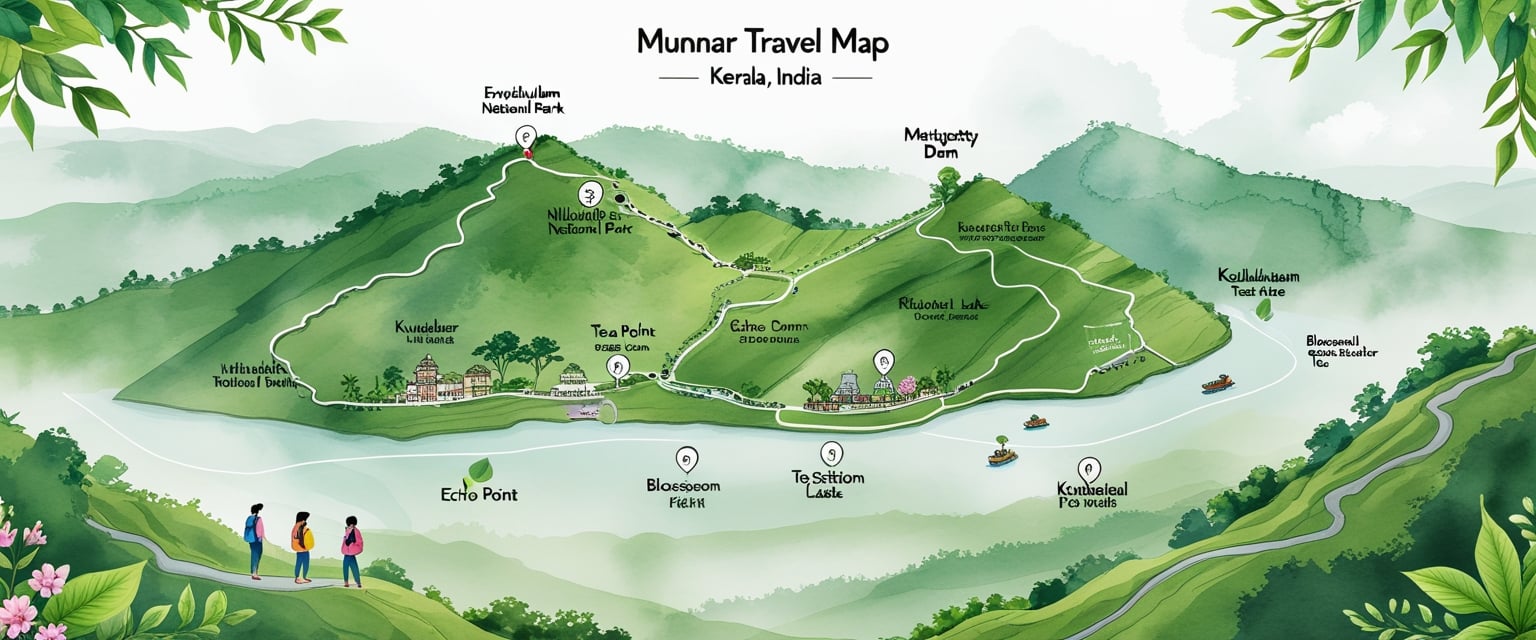The best time to visit Munnar is from October to February, when the weather is pleasantly cool and ideal for families, honeymooners, and anyone who wants to experience the region’s misty hills and lush landscapes. During these months, the pretty hill station comes alive with clear views, vibrant greenery, and comfortable temperatures—making sightseeing, trekking, and tea plantation visits easy and enjoyable for all types of travelers. This period is especially recommended for those traveling with family or seeking a romantic getaway, as the atmosphere is both comfortable and inviting, with festive winter events and fewer rain disruptions.
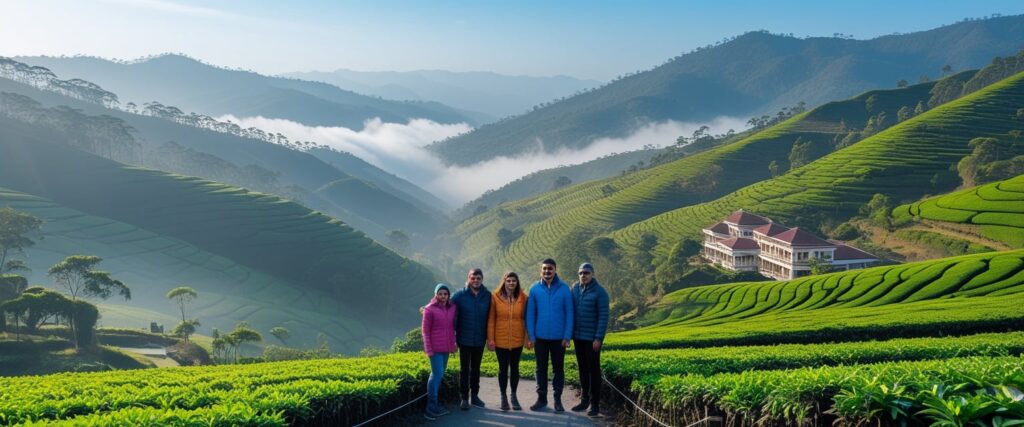
The worst time to visit Munnar is generally during the peak monsoon season, from June to August, when heavy rains can cause landslides, slippery roads, and limit outdoor activities. Although the rainy season transforms the hills into a lush, green paradise, the persistent downpours make sightseeing and forest treks less accessible for families and less safe for those unfamiliar with the area. For travelers considering a trip in April, the weather is moderate, activities like trekking remain enjoyable, and it serves as a good choice to escape the heat of the plains, but humidity starts to rise and you may experience the start of occasional pre-monsoon showers; detailed advice on April and other months can be found in a month-by-month guide to Munnar’s seasons.
If you are looking for a medical tourism article, please click here.
For the best experience across Munnar and nearby destinations like Kodaikanal, the post-monsoon and winter months offer clear skies and well-maintained roads, perfect for exploring local highlights such as Eravikulam National Park, Attukad Waterfalls, and tea gardens. With these guidelines, travelers can confidently plan the best season to enjoy Munnar’s unique beauty and avoid the common pitfalls of visiting at the wrong time.
Table of Contents
Best and Worst Seasons to Visit Munnar
Munnar’s hill station weather changes distinctly with each season, directly affecting travel experiences. While winters offer crisp air and clear views, the monsoon brings lush landscapes but possible travel disruptions.
Munnar Best Season to Visit
The best season to visit Munnar is winter, which runs from December to February. During these months, temperatures usually range from 10°C to 15°C, and days are mostly cool and pleasant. This period is ideal for sightseeing, trekking, and enjoying Munnar’s tea plantations without discomfort from heat or humidity.
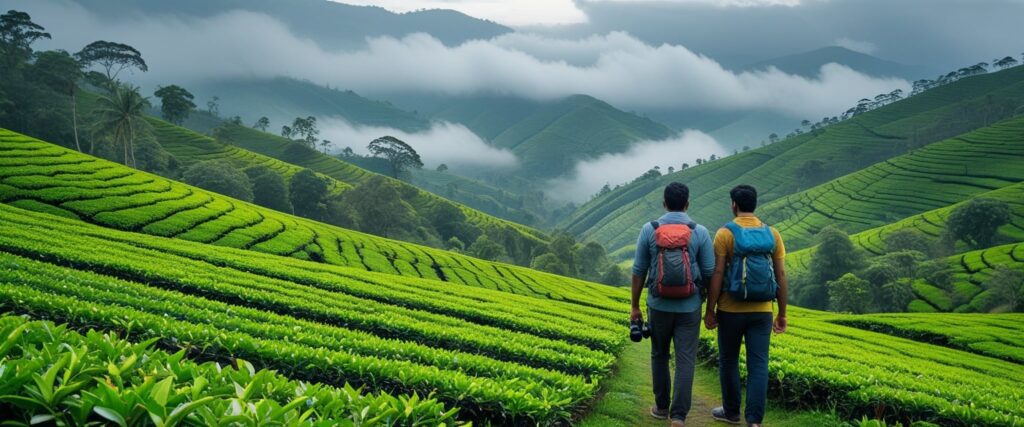
Visiting iconic spots such as Eravikulam National Park, Mattupetty Dam, and the Tea Museum is more enjoyable when skies are clear. Winters are also the peak season for the hill station, so travelers should book accommodations well in advance. Outdoor activities such as hiking to Anamudi Peak or venturing through spice gardens are best done during this time. For a detailed Munnar weather guide for each season, winter consistently stands out as the prime time to plan a Munnar trip.
Best Time to Visit Munnar With Family
Families find the most comfort visiting Munnar from October to May. October and November mark the post-monsoon period when the region’s hills and tea gardens are fresh and vibrant after the rains. During summer, from March to May, day temperatures are warmer (18°C to 25°C), but evenings stay cool, making it enjoyable for children and elderly travelers alike.

These periods are less prone to heavy rain, offering safe and accessible roads for sightseeing and outdoor activities. Family-friendly attractions include Top Station, Kundala Lake, Blossom Park, and guided tea plantation tours. Families can explore wildlife at Eravikulam National Park and enjoy boating or picnics without worrying about unpredictable weather. The combination of pleasant weather and vibrant scenery makes these months the best time to visit Munnar with family.
Best Time to Visit Munnar for Honeymoon
Couples seeking a romantic escape often choose Munnar during winter, especially December through February. Misty mornings, cool temperatures, and clear nights create an intimate setting perfect for honeymooners. The valley is dotted with cozy resorts that offer privacy and stunning views of rolling hills and tea estates.
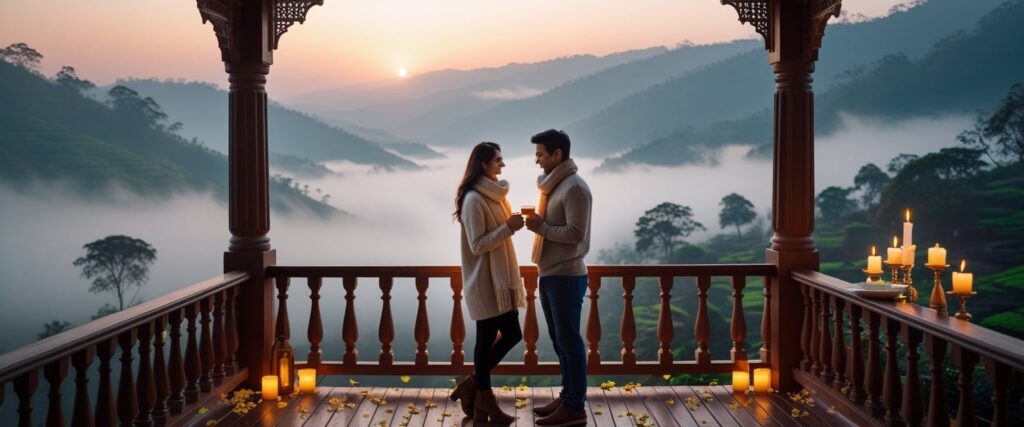
Winter provides the ideal backdrop for candlelight dinners, private walks among cloud-kissed gardens, and panoramic viewpoints like Echo Point and Pothamedu View Point. Newlyweds can also indulge in adventure activities such as rock climbing or nature trails, balancing relaxation and exploration. This season combines favorable weather with scenic beauty, making it the best time to visit Munnar for honeymoon.
Worst Time to Visit Munnar
The worst time to visit Munnar is during the peak monsoon season from June to September. Heavy rainfall brings dense fog, slippery trails, and the risk of landslides. Many roads can become blocked, and outdoor activities or visits to certain viewpoints may be limited due to poor visibility and continuous drizzle.
Travelers should be aware that while Munnar is exceptionally green during this time, the wet weather can lead to travel delays and restricted access to major attractions. Families, in particular, may face challenges as sightseeing could be disrupted or canceled unexpectedly. For detailed warnings on travel interruptions and hazards, see recommendations on the worst time to visit Munnar.
Seasonal Travel Insights and Places to Visit in Munnar
Munnar’s climate and natural beauty change with each season, shaping visitor experiences. Timing a visit can affect everything from crowd levels to access to its top attractions and the quality of outdoor activities.
Rainy Season in Munnar
The monsoon in Munnar typically arrives from June to September. During this period, the region sees frequent, sometimes heavy, rainfall that revives its lush tea plantations and fills waterfalls like Chinnakanal and Lakkam. The town transforms into a green haven, with mist swirling among the hills of the Western Ghats.
Travelers who enjoy solitude and cooler temperatures find this season ideal for a calm getaway. However, persistent rain can make trekking routes slippery and some roads challenging. Outdoor exploration may be limited, so it is recommended to monitor local weather conditions. Accommodations are usually less expensive during the monsoon, making it attractive for budget-minded visitors.
Photographers, in particular, value this season for vibrant contrast and unique misty landscapes. To maximize comfort, it’s wise to pack waterproof clothing and stay informed about accessibility before planning long excursions.
Is April Good Time to Visit Munnar
April marks the middle of summer in Munnar, with average temperatures ranging from 18°C to 25°C. The climate remains much cooler compared to other parts of Kerala or major cities like Bangalore. The evenings are cool and pleasant, while the afternoons are usually warm but rarely uncomfortable.
April is a popular time for families escaping the heat elsewhere in India. The natural surroundings, particularly places such as the Tea Museum, Eravikulam National Park (home to the endangered Nilgiri Tahr), and Mattupetty Dam are fully accessible for sightseeing. The flora is lush, and skies tend to be mostly clear, allowing for uninterrupted panoramic views.
While it can be moderately crowded due to school vacations, the environment remains peaceful if you book stays at one of the best resorts in Munnar or in surrounding areas. Recommended clothing includes light cottons and a light jacket for evenings.
Worst Time to Visit Munnar With Family
The period of heavy monsoon (June-August) is often considered the worst time to visit Munnar with family, especially with young children or elderly relatives. Constant rainfall can restrict movement, and certain areas may become less safe due to slippery roads and potential landslides.
Many popular outdoor spots, such as Echo Point and trekking trails, are not always accessible. Day tours and longer trips to places like Blossom International Park may need to be canceled at short notice. The chances of leeches and other minor irrigation issues in the tea gardens also increase.
If family members have respiratory concerns or mobility issues, the damp atmosphere and variable weather could exacerbate discomfort. For a smoother experience, families should consider avoiding this period and instead look toward the post-monsoon or winter months, when the air is clear and outdoor recreation is safer and more enjoyable.
Best Time to Visit Munnar and Kodaikanal
For travelers visiting both Munnar and Kodaikanal, the best months are between October and February. During this window, the climate is cool, skies are clear, and landscapes are at their most vibrant following the post-monsoon refresh.
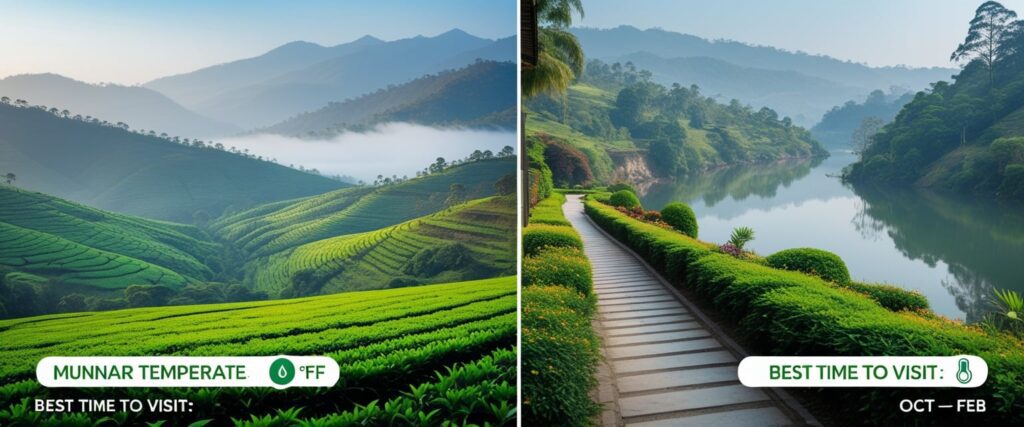
Both hill stations are at their peak for sightseeing, trekking, and scenic drives. Key attractions such as the rolling tea gardens of Munnar, Eravikulam National Park, and the picturesque lakes and valleys of Kodaikanal can be enjoyed without weather-related disruptions. This is also when the Nilgiri Tahr is frequently spotted in Eravikulam.
Here is a quick comparison:
| Aspect | Munnar | Kodaikanal |
|---|---|---|
| Ideal Months | Oct-Feb | Oct-Feb |
| Avg. Temp (°C) | 10-20 | 8-20 |
| Main Attractions | Tea gardens, Eravikulam, Mattupetty Dam | Lake, Coaker’s Walk, Bryant Park |
Travel in these months also features shorter waiting times at attractions and better availability at popular resorts.
Munnar Best Places to Visit
Munnar is home to varied attractions that appeal to families, couples, solo travelers, and adventure seekers. Some of the best places to visit include:
- Eravikulam National Park: Known for the Nilgiri Tahr and widespread grasslands.
- Mattupetty Dam: A favorite for boating and enjoying mountain views.
- Echo Point: Famous for natural echoes, scenic vistas, and photo opportunities.
- Blossom International Park: Well-maintained parklands suitable for picnics and strolls.
- Chinnakanal Waterfall: Dramatic and photogenic, especially after rains.

Other noteworthy sites are the kundala tea plantations, Attukal Waterfalls, and the Kolukkumalai Tea Estate, reputed as the world’s highest tea plantation. Accommodations range from budget-friendly homestays to luxury resorts in Munnar, with many offering valley views.
For route options, Bangalore to Munnar is popular for road trips, allowing stops at various viewpoints along the Western Ghats. Families, honeymooners, and nature lovers will find suitable activities and sights year-round, provided they plan for the season’s conditions using guidance from accurate travel guides such as this season-by-season overview.
Conclusion
Munnar offers a magical escape year-round, but planning your visit according to the season can make all the difference. For families and honeymooners, the post-monsoon and winter months—from October to February—provide the most comfortable and scenic experience, with clear skies, cool temperatures, and easy access to iconic attractions. While the monsoon season paints Munnar in lush greenery, it brings travel challenges that are better avoided, especially by those with children or elderly companions. Whether you’re chasing misty views, romantic sunsets, or quiet time in nature, choosing the right season will ensure your trip to Munnar is not just enjoyable, but truly unforgettable.
